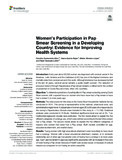Mostrar el registro sencillo del ítem
Women’s participation in pap smear screening in a developing country: evidence for improving health systems
| dc.creator | Santamaría Ulloa, Carolina | |
| dc.creator | Quirós Rojas, Ileana | |
| dc.creator | Montero López, Melina | |
| dc.creator | Quesada Leitón, Hazel | |
| dc.date.accessioned | 2021-11-17T15:01:32Z | |
| dc.date.available | 2021-11-17T15:01:32Z | |
| dc.date.issued | 2021-06-15 | |
| dc.identifier.citation | https://www.frontiersin.org/articles/10.3389/fonc.2021.642841/full | |
| dc.identifier.uri | https://hdl.handle.net/10669/85216 | |
| dc.description.abstract | Introduction: Every year about 83,000 women are diagnosed with cervical cancer in the Americas. Latin America and the Caribbean (LAC) has one of the highest incidence and mortality rates from cervical cancer in the world. Although incidence has decreased by half in the last 30 years, cervical cancer remains a public health concern. The detection of precursor lesions through Papanicolaou (Pap) smear remains a critical tool in the context of prevention in Costa Rica and many other LAC countries. Objective: To determine predictors of participation in Pap smear screening among Costa Rican women, with a special focus on women who have never had a Pap smear or have had a smear 5 or more years ago. Methods: The data source for this study is the Costa Rican Households National Survey conducted in 2014. This survey is representative at the national, urban/rural zone, and administrative region level. A subsample of women aged 20 to 69 years who responded to the survey’s Papanicolaou Module were included in this study (n = 11,709). Statistical analyses were conducted in R-Studio. Statistical significance level was set at 5%. Two multinomial regression models were estimated. The first model aimed to explain the five different categories of cytology use, which were defined according to the last time women had a Pap smear. The second model aimed to explain the five different categories of reasons why women had never had a Pap smear. Both models controlled for age, educational attainment, and marital status. Results: Young women with high educational attainment were more likely to have never had a cytology. Women with a lower educational attainment, married, or in domestic relationship and of older age had greater odds of having had a cytology 5 or more years ago. Each year increment in age was significantly associated with an increase in the odds of never having a Pap smear because of health care access issues or because of cultural reasons as compared to not having an active sexual life. Conclusions: Findings can inform public policy targeted to higher risk female populations where access to health services can be improved. | es_ES |
| dc.language.iso | eng | es_ES |
| dc.source | Frontiers in Oncology, vol.11, pp.1-9 | es_ES |
| dc.subject | Papanicolaou | es_ES |
| dc.subject | Prevention | es_ES |
| dc.subject | Cervical cancer | es_ES |
| dc.subject | Screening | es_ES |
| dc.subject | Women’s health | es_ES |
| dc.title | Women’s participation in pap smear screening in a developing country: evidence for improving health systems | es_ES |
| dc.type | artículo original | |
| dc.identifier.doi | 10.3389/fonc.2021.642841 | |
| dc.description.procedence | UCR::Vicerrectoría de Investigación::Unidades de Investigación::Ciencias de la Salud::Instituto de Investigaciones en Salud (INISA) | es_ES |
| dc.description.procedence | UCR::Vicerrectoría de Docencia::Ciencias Sociales::Facultad de Ciencias Económicas::Escuela de Estadística | es_ES |


